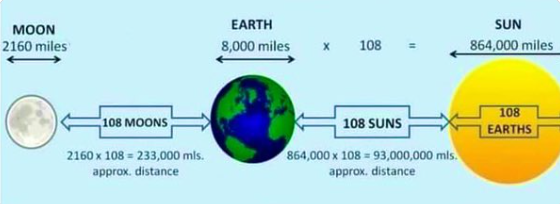Number 108 – Understanding Its Symbolism and Importance
Have you ever wondered why some numbers seem to hold a special place in our hearts and minds? One such number is 108, and today, we’re going to dive into why it’s considered so sacred.
So, why do people around the world hold the number 108 in such high regard? Well, it turns out that this number has deep roots in various cultures and spiritual traditions. Let’s take a closer look at why it’s so important
Firstly, let’s talk about why the number 108 is significant. For many, it represents completeness and unity. You see, the number 1 symbolizes the beginning, 0 represents the infinite, and 8 signifies the end. So, when you put them all together, you get a sense of wholeness and harmony.
Why number 108 is so sacred?
In many belief systems, 108 symbolizes completeness and unity. When you break down the number, 1 represents the beginning, 0 signifies the infinite, and 8 represents the end. Together, they create a sense of wholeness and harmony.
In Hinduism, Buddhism, and other Eastern spiritual traditions, there are 108 beads on a mala, a string of prayer beads used for meditation and chanting. Each bead represents a mantra or prayer, allowing practitioners to focus their minds and connect with their spiritual practice.
Hinduism teaches that there are 108 sacred sites throughout India, known as pilgrimages. Visiting these sites is believed to bring spiritual enlightenment and blessings, making the number 108 associated with divine exploration and journey.
In astrology, there are 12 houses and 9 planets, resulting in 108 possible combinations of planetary placements in a birth chart. This connection between the cosmos and human life adds to the sacredness of the number.
From a numerological perspective, 108 is an abundant number, meaning that the sum of its proper divisors exceeds the number itself. This mathematical property adds to the mystique and significance of 108.
Sun-Earth-Moon Relationship

- Sun’s Diameter and Earth’s Distance:
- Diameter of the Sun = 1,391,000 kilometers
- Diameter of the Earth = 12,742 kilometers
- Ratio = Sun’s Diameter / Earth’s Diameter = 1,391,000 / 12,742 ≈ 109.17
- The ratio is approximately 109, which is close to 108.
- Earth-Moon Distance:
- Average distance between Earth and Moon = 384,400 kilometers
- Diameter of the Moon = 3,474.8 kilometers
- Ratio = Earth-Moon Distance / Moon’s Diameter = 384,400 / 3,474.8 ≈ 110.62
- The ratio is approximately 111, which is close to 108.
- Sun-Earth Distance (1 AU):
- Average distance between Earth and Sun (1 AU) = 149,600,000 kilometers
- Diameter of the Sun = 1,391,000 kilometers
- Ratio = Sun-Earth Distance / Sun’s Diameter = 149,600,000 / 1,391,000 ≈ 107.61
- The ratio is approximately 108.
These calculations show that while the exact ratio may not be precisely 108, the relationships between the sizes and distances of these celestial bodies are remarkably close to this sacred number. This reinforces the intriguing connections between astronomical phenomena and numerical symbolism in various cultures and traditions.
Some more interesting facts about this Angel No. 108
- The number 108 is associated with the speed of light in miles per second, approximately 186,282 miles per second.
- The atomic number of hassium, a synthetic chemical element, is 108.
- The sum of the internal angles of a regular pentagon is 1080 degrees, with each angle measuring 108 degrees.
- In Buddhism, there are said to be 108 defilements or impurities that one must overcome to achieve enlightenment.
- There are 108 Upanishads, which are ancient texts that explore the nature of reality and the self in Hindu philosophy.
- The average human heart beats approximately 108 times per minute during moderate exercise.
- In Ayurveda, there are 108 marma points or vital energy points in the body.
- There are 108 stitches on a baseball.
- The sum of the first 9 positive integers (1 + 2 + 3 + … + 9) equals 45, and when multiplied by 2 gives 90, which is half of 180, the sum of angles in a triangle. Multiplying by 2 again yields 180, which is the sum of angles in a straight line, and doubling once more gives 360, the number of degrees in a circle.
- The holy River Ganga stretches across a longitude of 12 degrees (from 79 to 91) and a latitude of 9 degrees (from 22 to 31). When we multiply the number of degrees in longitude (12) by the number of degrees in latitude (9), we get 108.
- Many traditional mantras and chants consist of 108 repetitions, reinforcing the spiritual potency and transformative power of sound vibrations. The rhythmic recitation of these sacred syllables is believed to purify the mind, body, and spirit.
In conclusion, the number 108 is much more than just a mathematical figure; it is a symbol deeply woven into the fabric of spirituality and ancient wisdom. Across cultures and traditions, from Hinduism to Buddhism and beyond, 108 holds profound significance, representing completeness, unity, and cosmic harmony. 108 holds a central place in spirituality, representing wholeness, unity, and the interconnectedness of all beings with the divine. It serves as a reminder of the profound mysteries of existence and the journey toward spiritual awakening and enlightenment.
